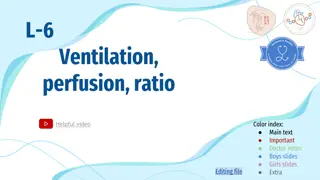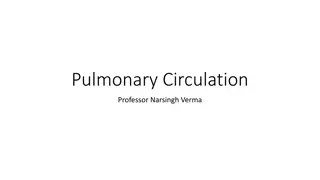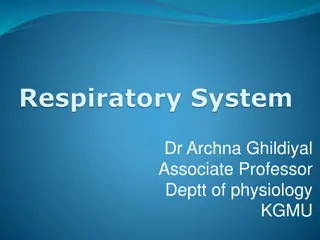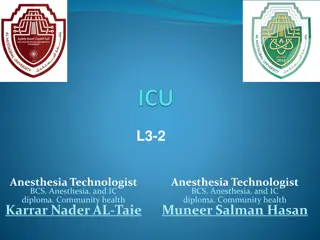Understanding Ventilation-Perfusion Ratio in Pulmonary Circulation
This lecture delves into the intricate relationship between ventilation and perfusion in the lungs, highlighting the importance of proper gas exchange for optimal respiratory function. It discusses the circulations supplying the lungs, defines the V/Q ratio, and explores the clinical significance of abnormalities in this ratio. Through detailed explanations and visuals, the presentation elucidates concepts such as physiological shunt, lung zones, and wasted ventilation, offering a comprehensive insight into the dynamics of ventilation-perfusion matching.
Download Presentation

Please find below an Image/Link to download the presentation.
The content on the website is provided AS IS for your information and personal use only. It may not be sold, licensed, or shared on other websites without obtaining consent from the author. Download presentation by click this link. If you encounter any issues during the download, it is possible that the publisher has removed the file from their server.
E N D
Presentation Transcript
LECTURE-5 VENTILATION PERFUSION RATIO Dr. Maha Saja Msaja@ksu.edu.sa Office no. 8 level 3
Objectives Recognize the high pressure and low pressure circulations supplying the lung. Identify the meaning of the physiological shunt in the pulmonary circulation. State the different lung zones according to the pulmonary blood flow. Define the V/Q ratio and its regional variation. Explain the clinical significance of the V/Q ratio Describe the abnormal patterns of the V/Q ration vice, shunt and dead space patterns.
Introduction For normal gas exchange to occur, ventilated alveoli must also be perfused with blood to achieve proper gas exchange. Ventilation Perfusion
Introduction If alveolus is ventilated but NOTperfused If alveolus is perfused but NOTventilated PO2= 104mmHg PCO2= 40mmHg PO2= 104mmHg PCO2= 40mmHg PO2= 40mmHg PCO2= 45mmHg PO2= 104mmHg PCO2= 40mmHg Wasted ?? Wasted ventilation
We talked a lot about ventilation in previous lectures, so why don t we discuss Pulmonary Perfusion
Circuitry Circuitry Low pressure circulation Why?? High pressure circulation Why??
Blood Supply of the Lung The lung has dual blood supply Pulmonary Circulation Bronchial Circulation Starts from Aorta Bronchial arteries capillaries Bronchial veins which drain either into pulmonary veins (i.e. Lt atrium) or right atrium. Starts at Rt atrium Rt ventricle Pulmonary art. Capillaries Pulmonary veins Lt atrium. Supplies deoxygenated blood to lungs to become oxygenated. Supplies oxygenated blood to lung tissue. 100% of CO Approximately 1-2% of CO Low pressure, high flow circulation. High pressure, low flow circulation.
Bronchial Circulation Supplies O2-rich blood to lung tissue. After lung tissue extracts the needed O2, deoxygenated blood drains into pulmonary veins (which carry O2-rich blood to the Lt atrium) causing venous admixture of deoxygenated blood with newly oxygenated blood coming from the pulmonary circulation. 23of the resultant Anatomic Rt-to-Lt Shunt Venous blood enters the O2-rich pulmonary vein
Right-to-Left Shunt Normally, deoxygenated blood should pass to the lungs to get oxygenated. If deoxygenated blood bypasses the lungs and enters the left side of the circulation Rt-to-Lt shunt
Pulmonary Perfusion Pulmonary perfusion refers to the blood flow through the lung that supplies deoxygenated blood to the lung to be oxygenated. This means pulmonary circulation . From now on we will focus on pulmonary circulation.
Pulmonary Blood Flow Pulmonary perfusion or pulmonary blood flow is affected by several factors: 1. Alveolar oxygenation. 2. Hydrostatic pressure gradient (the effect of gravity). 3. And other factors that will not be discussed.
Alveolar Oxygenation in alveolar PO2 (PO2 < 73mmHg) Vasoconstriction of the vessels surrounding the hypoxic alveolus This causes blood to flow to areas of the lungs that are better aerated N. B. This is opposite to the effect observed in systemic vessels
The Hydrostatic Pressure Gradient In the upright position, the pressure of blood is not the same around the body Why? Due to weight of the blood column, the effect of gravity. For each cm distance above or below the heart the pressure changes 0.77mmHg.
The Hydrostatic Pressure Gradient in the Lung The same effect happens in the lung. 15 mmHg less that Pulmonary arterial pr. at the level of the heart The distance between apex and base of lung 30cm.. Which means 23mmHg pressure difference between apex and base of the lung. 30cm = 23 mmHg 15mmHg above the heart and 8mmHg below the heart. 8 mmHg more that Pulmonary arterial pr. at the level of the heart
Regional Differences in Pulmonary Blood Flow The variation in arterial & venous pressures in the upright posture causes regional differences in blood flow. Base has more blood flow than apex in the upright posture.
Perfusion Zones of the Lung Classically, the lung has been divided into 3 different zones: Zone 1: No blood flow. Zone 2: Intermittent blood flow. Zone 3: Continuous blood flow.
Perfusion Zones of the Lung Zone 1-the alveolar capillary pressure never rises higher than alveolar air pressure throughout the cardiac cycle. Zone 2-the alveolar capillary pressure becomes higher than alveolar air pressure only during systole. Zone 3-the alveolar capillary pressure remains higher than alveolar air pressure throughout the cardiac cycle.
Perfusion Zones of the Lung Zone 1 is not normally seen in the lung.. When can zone 1 be seen in the lung? Normal lungs have only zones 2 & 3; Zone 2 at the apices. Zone 3 in all lower areas. Zone 2 blood flow begins in the normal lung about 10cm above the midlevel of the heart and extends from there to the top of the lungs. What happens in a person who is lying down?
What about ventilation?!! Is it affected by gravity as well?
Regional Differences in Pulmonary Ventilation Regional distribution of lung volume, including alveolar size and location on the pressure volume curve of the lung at different lung volumes. Because of suspension of the lung in the upright position, the pleural pressure (Ppl) and translung pressure (PL) of units at the apex will be greater than those at the base. These lung units will be larger at any lung volume than units at the base. The effect is greatest at residual volume (RV), is less at functional residual capacity (FRC), and disappears at total lung capacity (TLC). Note also that because of their location on the pressure-volume curve, inspired air will be differentially distributed to these lung units; the lung units at the apex are less compliant and will receive a smaller proportion of the inspired air than the lung units at the base, which are more compliant (i.e., reside at a steeper part of the pressure-volume curve).
Ventilation/Perfusion Ratio (V/Q Ratio) It is the ratio of alveolar ventilation to pulmonary blood flow per minute. The alveolar ventilation at rest (4.2 L/min) The pulmonary blood flow is equal to right ventricular output per minute (5L/min) V/Q ratio= 4.2/5 = 0.84 Alveolar ventilation is 80% of the value for pulmonary blood flow if the tidal volume and cardiac output are normal. 22
Variation in V/Q in the zones of the lung V/Q is uneven in the three zones. At the apex V/Q ratio = 3 At the base V/Q ratio=0.6 The apex is more ventilated than perfused and the base is more perfused than ventilated. During exercise the V/Q ratio becomes more homogenous among different parts of the lung.
V/Q Ratio The main function of this ratio is to determine the state of oxygenation in the body. Apex V/Q ratio = 3 (moderate degree of physiologic or normal dead space). Base V/Q ratio= 0.6 ( represent a physiologic or normal shunt). Any mismatch in the ratio can result in hypoxia. 24
Abnormalities in V/Q Ratio Changes in V/Q ratio can be caused by changes in ventilation or perfusion or both. In airway obstruction: alveolar ventilation is affected (shunt). In pulmonary embolism: perfusion is affected (dead space). 25























